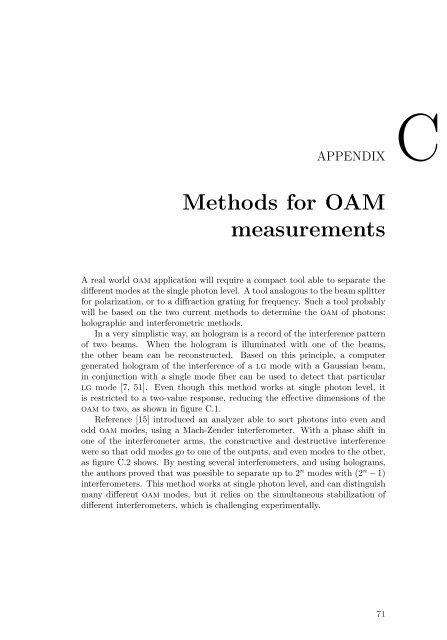Spatial Characterization Of Two-Photon States - GAP-Optique
Spatial Characterization Of Two-Photon States - GAP-Optique
Spatial Characterization Of Two-Photon States - GAP-Optique
You also want an ePaper? Increase the reach of your titles
YUMPU automatically turns print PDFs into web optimized ePapers that Google loves.
APPENDIX C<br />
Methods for OAM<br />
measurements<br />
A real world oam application will require a compact tool able to separate the<br />
different modes at the single photon level. A tool analogous to the beam splitter<br />
for polarization, or to a diffraction grating for frequency. Such a tool probably<br />
will be based on the two current methods to determine the oam of photons:<br />
holographic and interferometric methods.<br />
In a very simplistic way, an hologram is a record of the interference pattern<br />
of two beams. When the hologram is illuminated with one of the beams,<br />
the other beam can be reconstructed. Based on this principle, a computer<br />
generated hologram of the interference of a lg mode with a Gaussian beam,<br />
in conjunction with a single mode fiber can be used to detect that particular<br />
lg mode [7, 51]. Even though this method works at single photon level, it<br />
is restricted to a two-value response, reducing the effective dimensions of the<br />
oam to two, as shown in figure C.1.<br />
Reference [15] introduced an analyzer able to sort photons into even and<br />
odd oam modes, using a Mach-Zender interferometer. With a phase shift in<br />
one of the interferometer arms, the constructive and destructive interference<br />
were so that odd modes go to one of the outputs, and even modes to the other,<br />
as figure C.2 shows. By nesting several interferometers, and using holograms,<br />
the authors proved that was possible to separate up to 2 n modes with (2 n − 1)<br />
interferometers. This method works at single photon level, and can distinguish<br />
many different oam modes, but it relies on the simultaneous stabilization of<br />
different interferometers, which is challenging experimentally.<br />
71



